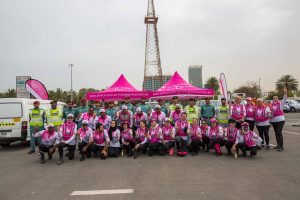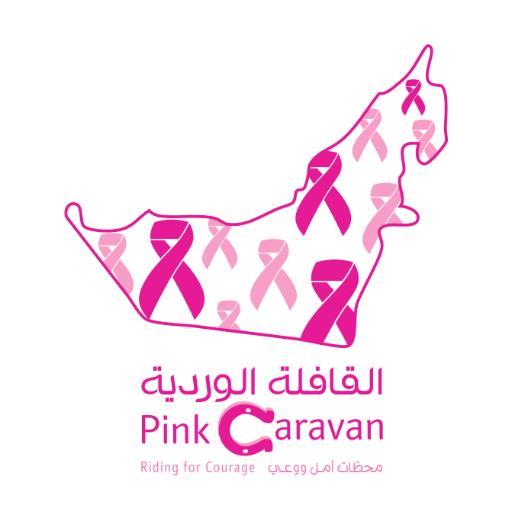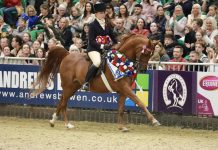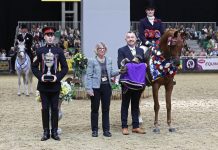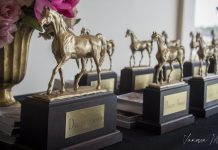An interview with Dagmar Pauline Heinke
What is the Pink Caravan Ride and how did the idea develop?
It was the idea of four strong and powerful women: Dr Sawsan Abdul Salam Al Madhi from the United Arab Emirates (UAE), Debbie Armaly from the United Kingdom, Lize de Yong from South Africa, and Sunny Hogan from the USA.
The great and long-term engagement of these four ‘good fairies’ enormously contributed to the success of Pink Caravan.
Dr Sawsan is the Director General of Friends of Cancer Patients (FoCP) and Head of the Pink Caravan Medical and Awareness Committee in Sharjah, UAE. She is an engaged female doctor who demonstrated heavy commitment for the founding of a Government breast cancer prevention center.
Debbie is a British woman considered to be the good soul of the Pink Caravan Ride. She has lived and worked in Dubai for more than 20 years, accounting for her long-term experience as an expat. She is a classical rider and has been a member of the Pink Caravan organisation team since the beginning. Debbie is always looking for permanent improvement and is a very talented organiser; she liaises with the authorities and takes care of the smooth running of the ride. She is careful that all riders comply with the safety regulations and that they to adhere to a dress-code of black, pink and white. Debbie ensures the ride keeps to time and makes clear British military-style announcements.
Lize is a project manager for FoCP who has lived and worked in the UAE for years. She takes care of the hospitals role in this event and is responsible for media and donations.
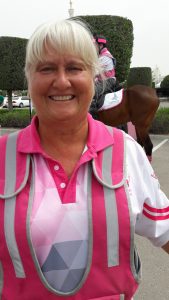 Sunny is a lively Texan woman whose role is to manage the horses. As a coach for western riding, she is a real cowgirl. Sunny does not want to sit on a horse in a ‘preppy’ way, but wants to feel the horse under her, and to form one unit with the horse. She scurries around the horses together with the horse-keepers the whole day from the sunrise till sunset. She chooses the necessary horse from the mews and supervises the loading in two big horse vans. Sunny also organises the setting up of equipment, as well as assessing whether the horses will get enough to drink or whether a horse is too frail and has to be replaced.
Sunny is a lively Texan woman whose role is to manage the horses. As a coach for western riding, she is a real cowgirl. Sunny does not want to sit on a horse in a ‘preppy’ way, but wants to feel the horse under her, and to form one unit with the horse. She scurries around the horses together with the horse-keepers the whole day from the sunrise till sunset. She chooses the necessary horse from the mews and supervises the loading in two big horse vans. Sunny also organises the setting up of equipment, as well as assessing whether the horses will get enough to drink or whether a horse is too frail and has to be replaced.
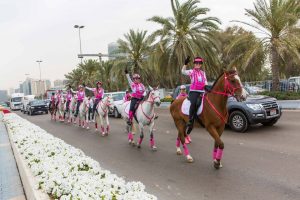
What is the mission of the Pink Caravan Ride?
To ensure that in all seven Emirates, all persons, as there are male breast cancer sufferers but especially women, have access to urgent breast cancer prevention.
There are mobile buses for mammography during the ten days of the Pink Caravan Ride, while in hospital people can receive advice and undergo a medical check-up free of charge, funded by the government. Colour and creed do not matter – all can be advised free of charge and in the case of a positive diagnosis, all arising costs will also be covered.
How long has the campaign been going for and for how long is it expected to continue?
The idea arose seven years ago. During this time, it was continuously upgraded with more and more people taking part year on year. This year was the first time that survivors and sufferers also took part in the ride for some of the distance. It is hoped that the Pink Caravan Ride will continue for a long time.
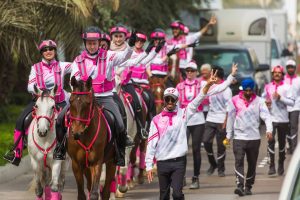
What was the route and were there any highlights along the way?
The United Arab Emirates comprise seven Emirates. The ride started in Fujairah, went through Ras al Khaimah, Umm Al Quwain, Ajman, Sharjah, Dubai, and then to the capital Abu Dhabi.
The highlight of the ride was seeing the big Sheikh Zayed Mosque in Abu Dhabi as well as the presence of His Highness Sheikh Mohammed Biy Zayed Al Nahyan, Crown Prince of Abu Dhabi and Supreme Commander of the Armed Forces of the United Arab Emirates, in the big Sheikh Zayed Sports Stadium for the final ceremony.
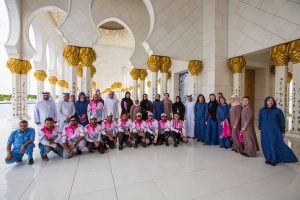
What was the daily routine?
People generally got up after sun rise, cared for the horses and loaded them (the horses were from two different mews of the Emirate Sharjah). The horses were brought to the corresponding meeting points where their riders and the whole team were waiting. The first phase started and after approximately two hours there was a break with drinking, feeding and washing with water to cool down. There was then a veterinary check and horses were put into a climate LWS chilled trailer to cool down. Following that was visiting sites like hospitals, universities, Ikea, Waterworld, Zayed mosque, big luxury hotels and malls.
The horses and riders were welcome all over. The voluntary helpers of Pink Caravan had already organised water for the horses, tents, merchandising and information stands. The whole team was actively assisted by the employees of the hotels, universities and hospitals and other sites on the route.
It is important for the riders to always look for a “silent place“ on the route, as their bladders become a little bit more sensitive from drinking and riding. Luckily very clean Dixi toilets were carried in the caravan for the riders to use.
While the horses could cool down in the chilled trailer, the grooms ate, drank or prayed (each horse had two grooms available). The grooms made a very good job, they took care of the horses in a very good and lovingly way, especially during the loading and unloading of the horses, which was a very interesting spectacle. They went up and down like little lambs.
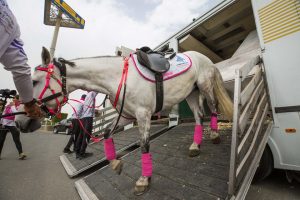 How many riders took part and how many horses were available?
How many riders took part and how many horses were available?
Each year there are approximately 100 selected riders.
This year there were 80 riders. A great number were designated stand-by riders and side-walkers. Some rode only a short track in case another rider dropped out.
It comprises only locals (Arabs) and expats who live in the United Arab Emirates. These expats mainly come from the United States of America, United Kingdom, Syria and Lebanon or other Arab countries and are living and working in the Emirates.
These locals are extremely good riders and are mainly male. Riding is a male domain in the Emirates, which is completely different to other countries such as in Germany. However, there are now an increasing number of female riders, who are mostly veiled.
The riders at the Pink Caravan generally do this year on year, and sometimes there is a new face. All riders have to pass a qualifying test on site, which decides whether their riding abilities are sufficient to participate.
There are ten to fifteen riders riding daily, and 30–35 horses are available daily. They are, without exception, endurance horses that only go to professional races and are fit for such work.
There are also a number of VIP’s in attendance to support the event, such as the daughters of His Highness Sheikh Mohammed bin Rashid Al Maktoum, who also ride in the Pink Caravan event. The enthusiastic horse rider, His Highness Sheikh Mohammed bin Rashid Al Maktoum, insists on walking beside the horses and its riders through the streets of Dubai. His Highness Sheikh Mohammed bin Rashid Al Maktoum is very popular and is a great example to his compatriots, therefore this gesture of solidarity with the subject of “riding against breast cancer” is of great symbolic importance. In the Emirates it is therefore a big honour to be allowed to ride with Pink Caravan.
Among the 100 plus chosen riders, were professional jockeys Tag O’Shea and Pat Dobbs. A few days later they rode in the Dubai World Cup at Meydan Racecourse, the highest endowed race in the world. It was an honour that they supported this ride with their participation.
Who coordinates the event?
Doctor Sawsan Abdul Salam Al Madhi, VAE, Director General of Friends of Cancer Patients (FoCP) and Lize de Yong, project manager with FoCP manage the coordination with all of the organisations involved and the Sheiks in the background. Doctor Sawsan Abdul Salam Al Madhi is also the Head of the Pink Caravan Medical and Awareness Committee. She strongly supported the founding of a government center for preventing breast cancer. Because she works for the Government, Sawsan Abdul Salam Al Madhi also takes care of the coordination between both FoCP and the Pink Caravan and is always on site.
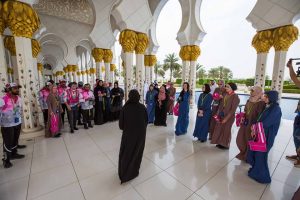
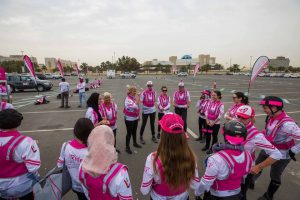
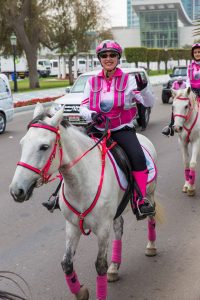 How do the locals react to the Pink Caravan Ride?
How do the locals react to the Pink Caravan Ride?
The Ride is well accepted by the local people, who usually stand at the roadside waving, whistling and take photos.
How do people find out about the availability of initial testing for Breast Cancer?
The location and dates of the mobile mammography unit is announced in the newspaper in advance. People can also meet at a meeting point or they make an appointment at the hospital.
The temperatures in the United Arab Emirates were partly above 40 degrees. How did the riders cope and how did you manage the needs of the horses?
As the riders are locals, they manage it very well as they are used to the temperatures, and because it is held at spring time the climate is usually cooler. However, because the locals never usually expose themselves to the sun for long periods of time and they live in an air conditioned areas, riding in the sun from the morning until the evening in warm riding clothes is of course very hot and exhausting.
Debbie Armaly keeps a very close eye on the fact that everybody takes suntan lotion; handkerchiefs, scarf and long sleeved shirts are a must. At each stop we immediately move into the shade (tents, roof covered places, the universities, hospitals and hotels).
We will get a lot to drink including still water, detox drinks, special electrolyte and organic fruit juices, in addition there is not only a veterinarian on site but also an emergency doctor. Two ambulance cars always follow us wherever we go as a precaution.
The horses are also used to these temperatures; they are all professional endurance horses used to competing in rides of between 90km and 160km. A tank car with fresh water for the horses always accompanies us. I always notice that at first the riders look after the horses before themselves. They take care that the saddle belt is slackened immediately after getting off and lead horses to the watering place. The grooms will arrive at once and take over their care.
There is also a vet check, which tests PAT, controls the pulse and checks for any lameness. In the event that a horse cannot take part further, it will immediately be taken to the hospital in an air-conditioned truck or by a trailer of Sunny Hogan.
What work do the horses do every day, who takes care that this is done responsibly, and that it is not too exhausting for the horses?
Their daily work is between 25km and 35km. Debbie Armaly and Sunny Hogan keep a very close eye on this compliance and the health of the horse. Also because the riders are very experienced they immediately inform the organisers if they recognize a problem with their horses.
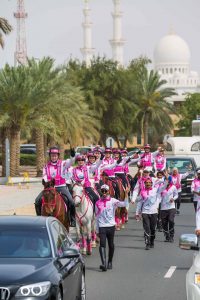 It is understood that the traffic there can be very dangerous, and since the ride has to cross some main streets, how is the safety of riders and horses managed?
It is understood that the traffic there can be very dangerous, and since the ride has to cross some main streets, how is the safety of riders and horses managed?
The Pink Caravan route is accompanied by the police in every Emirate. That means that we ride with a big escort. The first car in the convoy is the security chief of His Highness Sheikh Nahyan bin Mubarak Al Nahyanwho coordinates the operation with the chief of the Police.
There are police car jeeps, team cars and motorbikes in front, on both sides and at the rear of the riders. There are also drones and helicopters that keep an eye on the ride.
Where necessary, the total traffic will be blocked. The police take care that no car that does not belong to our ride, can run in (however, this does happen from time to time as there are careless car drivers). Permanently there are policemen and team members acting as side-walkers and there is also a special unit of the police (poor boys!) for additional safety. There are also further policemen in the corresponding Emirates to provide support.
At each border of an Emirate all policemen are replaced and are taken over by the Police Authority of the next Emirate. Like a relay race this runs smoothly. Some routes that are too dangerous for the horses will be detoured. The horses go in a trailer and riders in a bus.
From time to time there are sand storms and the horses get restless (although they are used to it). As it gets darker the sand blows very fast and plastic bags, posters, paper and even trashcans can fly through the air. The sand goes into the mouth, nose and eyes of both horse and rider. In this instance we wait until it gets better or we stop the ride.
Perhaps some figures: how many riders, horses, assistants, doctors, volunteers, kilometers, and participants for the screenings are there?
Within seven years the Pink Caravan Ride rode more than 1,440km through the seven Emirates. There were more than 400 riders, 650 volunteers and 455 hospitals that took part providing checkups. 41,391 people were screened, and of that 8,526 were men.
The Pink Caravan Ride has visited 84 schools and held informative lectures.
2017 in figures:
On the tenth and the last day of the Pink Caravan Ride, 139 mammograms, 27 ultrasound examinations and 354 screenings were done by 411 expats and 100 locals.
200 volunteers/logistic team
150 horses
100 riders
This great event is very well organised with a preparation time of more than six months. Security is very important, a special unit of the police protects horses and riders but especially the members of the royal family.
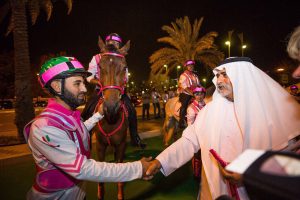
You have been riding for many years. What does the Pink Caravan Ride mean to you?
For me personally it is a very good feeling to help and to see a result at once. It feels wonderful to be part of the team and really help people. That’s why it is called the Pink Caravan Ride for courage. And to ride with a pink ribbon means to be brave, to ride an unknown horse, to withstand unknown routes, the sun and the sand, to be able to work in a team and to be tolerant, to respect a foreign culture and religion and to behave as a guest.
I’m of the opinion that we all should show more courage in everyday life. And to do it with manpower and to engage oneself in a cause you believe in. To do a money transfer is also important but it’s also very convenient. To contribute time and engagement in practice is very valuable: doing instead of talking is better.
What’s also special about the Pink Caravan is the enthusiasm for the event and the dedication of those involved in the arrangements throughout the Emirates. To reconcile so many participants is a brilliant achievement. And every year there are more and more people working together to counteract this insidious disease.
Most people involved are personally connected to breast cancer in some way – that motivates!
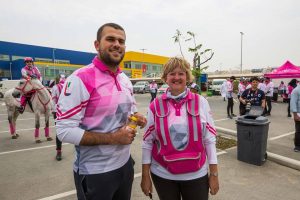 What is the Pink Ribbon and how is it related to the Pink Caravan?
What is the Pink Ribbon and how is it related to the Pink Caravan?
In Germany there is an organization called Pink Ribbon which also coordinates wonderful projects concerning breast cancer. Since they only started with horses this year, Pink Ribbon was a small event. Therefore we can follow the Pink Caravan’s Ride in Dubai and can also organise charity rides.
The Pink Ribbon does not have the organizational support of the Sheikhs and cannot close the whole city of Cologne, however we plan to start small from stable to stable. In Germany there are mostly women in the stables and that is the aim to be reached. As we are female riders, we can be ambassadors for a good cause.
Each rider and each stable can register in the Pink Ribbon route and people can also donate, with special actions being posted on the website of the Pink Ribbon to raise awareness.
